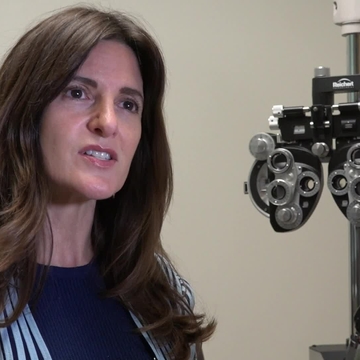New Mexico Approves Master of Science in Anesthesia Program at UNM

Summer Assault – New Mexico Climate, Geography Tough on Eyes
Forest fire smoke, chlorine in swimming pools, floating allergens and spinning fans all can stress our eyes in the summer. Add bone-dry air, sandstorms and high levels of ultra-violet rays, and serious eye damage can result.
UNM ophthalmologist Linda Rose, MD, sees all types of corneal damage in the high desert of New Mexico. Her clinical focus is on the cornea - the outermost surface of the eye (or, as Rose puts it, "the windshield in front of the white part").
"New Mexico is so arid," says Rose, who is the director of Cornea and External Diseases Services for the UNM Eye Clinic, and an associate professor in the UNM School of Medicine. "Some eyes get so dry they look like someone has taken a piece of sandpaper to our corneas and roughed them up." That's painful and oftentimes feels like there's actually something in the eye, she says.
Our eyes aren't completely defenseless against these ocular assaults. They blink and tear regularly, releasing layers of vital moisture protection.
"Healthy tears are made up of three basic layers," explains Rose. "Closest to the eye is the mucin layer, which provides a sticky surface to which tears attach. The middle layer is aqueous, or watery, and the outermost is the lipid layer containing a small amount of oil with each eye blink."
These stratified layers within tears protect against dry eye and other irritants that can take a toll on our comfort and vision, and result in dry eye syndrome. Dry eye happens when our eyes don't make enough tears and/or the tears dry up too quickly, Rose says. For some it happens as we age. For others, it can be a side effect of certain medications.
Worsening dry eye can make it difficult for some people to wear contact lenses and cause moderate to severe discomfort. Dry eye also can encourage cataract development.
"The lipids are the key," Rose says.
Our eyelashes contain glands that produce the lipid part of the natural eye lubricant. If these glands malfunction or become plugged, eye comfort and health suffer, resulting in burning, itching, redness, light sensitivity, blurred vision and other distressing symptoms.
"When a patient's eyes become chronically dry, I look at how the lids are functioning," she says. "As we age, our eyelids become less elastic - some to the point where the lids don't completely close or the glands become clogged. I can see a line across the eye surface where it's chronically exposed."
For quick relief, Rose suggests a warm compress to help unclog the glands that deliver the lipid layer to our tears. She recommends using raw rice in a sock or stocking heated to a tolerable level in a microwave oven. "Warm the eyelids for five to 10 minutes and then massage the outside of the lids to unclog the oil glands," she says.
There are other strategies to maintaining good eyelid elasticity and lipid secretion. "I call it lash hygiene," she says. "We need to wash our lashes regularly using warm water and a mild baby shampoo. Apply this solution to the base of the lashes and rinse it off after about a minute."
Good basic hydration, Omega-3 fatty-acid supplements and even humidifiers all can help minimize discomfort. Avoid being in the direct line of blowing vents and fans, and wear a hat, sunglasses and protective goggles.
"These are all simple things we can do to keep our eyes healthy," Rose says, "so they are more resilient when summer stressors abound."